India Most Famous Places: 16 Must-Visit Tourist Attractions in 2024
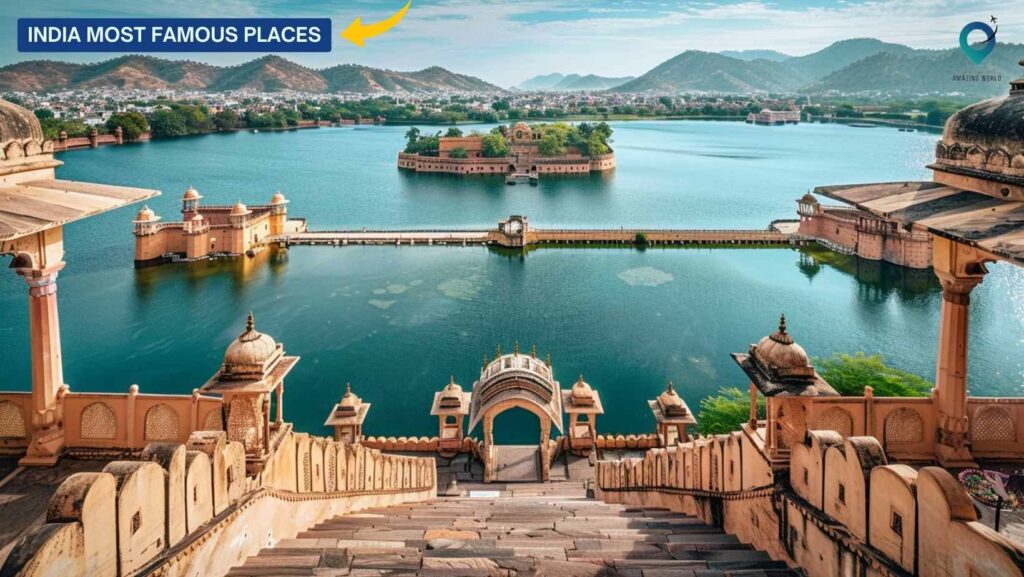
Are you someone who loves to travel and wants to explore Indian culture? Let’s dive into the melody of India’s top destinations for 2024. From the timeless beauty of the Taj Mahal in Agra to the spiritual vibes of Varanasi’s sacred river, get ready to experience India’s rich tapestry. Explore Jaipur’s colorful markets at Amer Fort and feel the history at Delhi’s Red Fort.
Relax on Goa’s sunny beaches, where every moment feels like a soothing melody by the sea. India is calling, promising an unforgettable journey of sights, sounds, and vibrant traditions. So, pack your bags and join the adventure—it’s time to discover India’s unforgettable charm! 🌟
List of 16 Must-Visit Tourist Attractions in India
1. The Taj Mahal, Agra

About the Place: The Taj Mahal in Agra is one of the most beautiful monuments in the world. Built by Mughal Emperor Shah Jahan in memory of his beloved wife Mumtaz Mahal, it symbolizes love and exquisite architecture. This white marble mausoleum, with its stunning gardens, intricate carvings, and majestic domes, is not just a UNESCO World Heritage site but a timeless masterpiece that attracts millions of visitors every year.
Place Address: Taj Mahal, Dharmapuri, Forest Colony, Tajganj, Agra, Uttar Pradesh 282001, India.
How to Get There
By Air: Fly into the Indira Gandhi International Airport (DEL) in Delhi. From there, take a direct train or hire a taxi to Agra, which is about 3.5 hours away. Alternatively, you can take a connecting flight to Agra’s Kheria Airport (AGR).
By Train: Catch a train to Agra from New Delhi Railway Station. The Gatimaan Express and the Shatabdi Express are popular choices, taking around 2-3 hours. Once you reach Agra Cantonment (AGC), take a taxi or auto-rickshaw to the Taj Mahal.
By Road: Agra is well-connected by road. From Delhi, drive via the Yamuna Expressway, which takes about 3-4 hours. Buses and taxis are also available from Delhi, Jaipur, and other nearby cities. You can get dropped at the Taj Mahal East Gate parking lot, then either walk or take a battery-operated vehicle to the entrance.
Local Transport in Agra: Once in Agra, you can use cycle rickshaws, auto-rickshaws, or taxis to get to the Taj Mahal. You can also hire a car if you prefer more comfort.
Why to Visit: The Taj Mahal is more than just a magnificent structure; it’s a monument to eternal love and a pinnacle of Mughal architecture. The stunning symmetry, the ethereal glow of the marble under different lights, and the meticulous craftsmanship make it a sight to behold. Whether you visit at sunrise, when the marble takes on a golden hue, or at sunset when it turns a soft pink, the Taj Mahal never fails to mesmerize. Walking through its beautiful gardens and reflecting pools, you can almost hear the whispers of history and romance.
Daily Average Budget
- Entrance Fee: ₹50 for Indians, ₹1100 for foreigners.
- Local Transport: ₹100-500 for auto-rickshaws/taxis.
- Food: ₹200-1000 per person, depending on the restaurant.
- Souvenirs: ₹100-500.
Estimated Total: ₹500-2100 per day.
Activities and Attractions
- Explore the Taj Mahal’s Main Mausoleum: Admire the intricate inlay work, marble screens, and the tombs.
- Walk Through the Gardens: Stroll through the symmetrical Mughal gardens (Charbagh) and enjoy the serene surroundings.
- Visit the Taj Museum: Learn about the history and construction of the Taj Mahal.
- Photography: Capture the Taj from various angles, especially from the main gateway and the reflecting pool.
- Experience the Views: Enjoy the stunning views of the Yamuna River and the Taj Mahal from different perspectives.
Things to Avoid
- Large Bags: Avoid bringing large bags, as they are not allowed inside the monument.
- Crowded Times: Avoid visiting during peak hours to escape the crowds.
- Unauthorized Guides: Steer clear of unauthorized guides; hire only government-approved guides.
- Littering: Do not litter; keep the site clean.
- Touching the Marble: Avoid touching or leaning on the marble to preserve its beauty.
Read full information here: The Ultimate Taj Mahal in Agra Guide
2. The Holy City of Varanasi
About the Place: Varanasi, one of the world’s oldest continuously inhabited cities, is a vibrant spiritual hub. Nestled along the sacred Ganges River, it’s where Hindu pilgrims come to wash away their sins in the river’s holy waters.
The city’s narrow, winding streets are a tapestry of temples, ashrams, and ghats (steps leading to the river), buzzing with religious fervor. Varanasi is also known for its rich tapestry of music, arts, and literature, offering an intoxicating blend of tradition and devotion.
Place Address: Varanasi, Uttar Pradesh, India.
How to Get There
By Air: Fly into Lal Bahadur Shastri International Airport (VNS), located about 26 km from the city center. From the airport, hire a taxi or use a prepaid taxi service to reach Varanasi.
By Train: Trains are a popular way to reach Varanasi. Major stations include Varanasi Junction (BSB) and Manduadih Railway Station (MUV). Trains from cities like Delhi, Kolkata, and Mumbai run regularly. From the station, you can take an auto-rickshaw or taxi to your destination.
By Road: Varanasi is well-connected by road. You can take a bus or hire a taxi from nearby cities. The NH 19 and NH 31 highways connect Varanasi to other major cities. The bus terminal is Varanasi Bus Stand (Cantt), from where local transport can be taken.
Local Transport in Varanasi: Use cycle rickshaws, auto-rickshaws, or taxis for getting around. Walking is also a great way to explore the narrow lanes and ghats.
Why to Visit: Varanasi offers a profound spiritual experience. Watching the Ganga Aarti, a daily evening ritual on the riverbanks, is a surreal experience, with hundreds of lamps and chants filling the air. The labyrinthine old city, with its temples and bustling bazaars, offers an authentic taste of India’s ancient culture.
You can also take a boat ride at dawn to see the city’s life unfold by the ghats, where pilgrims perform rituals and monks meditate. Varanasi is not just a city; it’s a living testament to India’s ancient spiritual and cultural traditions.
Daily Average Budget
- Boat Ride: ₹100-500 per person.
- Local Transport: ₹100-500 for rickshaws/taxis.
- Food: ₹200-800 per person.
- Temple Donations/Souvenirs: ₹50-500.
Estimated Total: ₹450-2300 per day.
Activities and Attractions
- Ganga Aarti: Attend the mesmerizing evening ceremony at Dashashwamedh Ghat.
- Boat Ride on the Ganges: Take an early morning or evening boat ride to see the ghats.
- Visit Kashi Vishwanath Temple: One of the most revered Hindu temples dedicated to Lord Shiva.
- Explore the Ghats: Walk along the ghats, observing rituals and local life.
- Sarnath Excursion: Visit Sarnath, where Buddha gave his first sermon, located about 10 km from Varanasi.
Things to Avoid
- Bargaining Too Hard: Avoid aggressive bargaining with local vendors; it’s often better to pay a fair price.
- Untrusted Boatmen: Use only trusted boat services; avoid deals that seem too good to be true.
- Overcrowded Areas: Avoid the ghats during peak hours to escape crowds.
- Photography Restrictions: Respect the signs that prohibit photography in certain religious areas.
- Unhygienic Food: Stick to eating at reputable places to avoid any food-related illness.
3. Harmandir Sahib (The Golden Temple), Amritsar
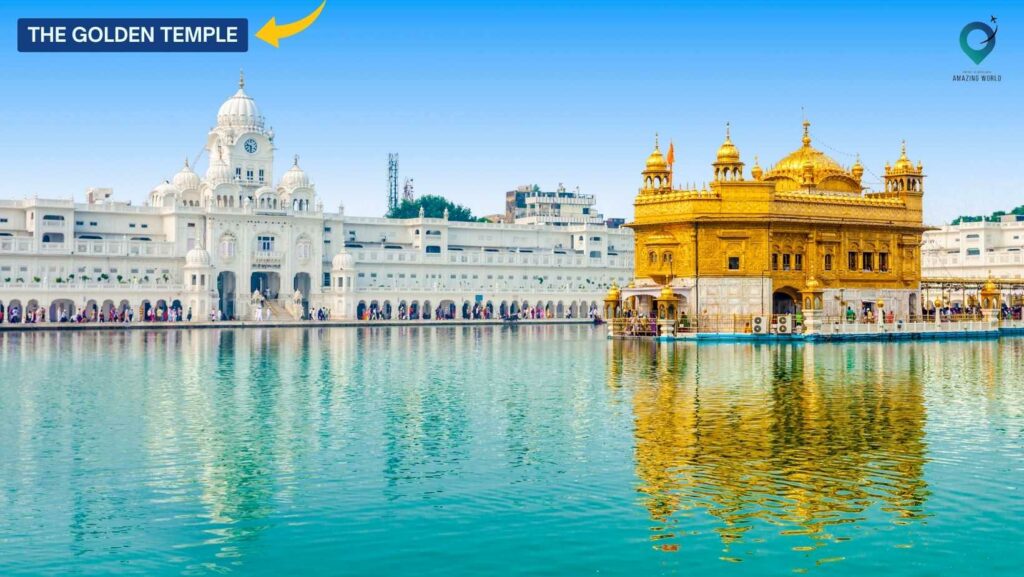
About the Place: The Harmandir Sahib, popularly known as the Golden Temple, is the most revered spiritual site in Sikhism. Located in Amritsar, Punjab, this stunning temple is renowned for its golden facade and serene surrounding waters. The temple’s shimmering reflection in the Amrit Sarovar (the holy tank) and the soothing sound of the continuous prayers create a tranquil and divine atmosphere. It’s a place where spirituality, history, and community service come together, offering visitors a unique and deeply moving experience.
Place Address: Golden Temple, Golden Temple Road, Atta Mandi, Katra Ahluwalia, Amritsar, Punjab 143006, India.
How to Get There
By Air: Fly into Sri Guru Ram Dass Jee International Airport (ATQ) in Amritsar, approximately 13 km from the city center. From the airport, take a taxi or use a ride-sharing service to reach the Golden Temple.
By Train: Amritsar Junction (ASR) is the nearest railway station. Trains from Delhi, Mumbai, and other major cities frequently arrive here. From the station, use a taxi or auto-rickshaw to get to the Golden Temple, about 3 km away.
By Road: Amritsar is accessible via NH 3 and NH 54. You can take a bus or hire a taxi from nearby cities. The main bus terminal is Amritsar ISBT, about 2.5 km from the Golden Temple. Local transport options are readily available.
Local Transport in Amritsar: Use auto-rickshaws, cycle rickshaws, or taxis to navigate the city. For a more traditional experience, try a tonga (horse-drawn carriage).
Why to Visit: Visiting the Golden Temple is a humbling experience that offers a glimpse into Sikh spirituality and hospitality. The temple’s striking architecture, with its gold-plated exterior and marble interiors, is breathtaking. Inside, the holy scripture (Guru Granth Sahib) is recited continuously, providing a peaceful ambiance.
The community kitchen (Langar) serves free meals to thousands of visitors every day, exemplifying the Sikh principle of selfless service. Walking through the temple complex, you feel a sense of unity and devotion that is both inspiring and heartwarming.
Daily Average Budget
- Entrance Fee: Free (Donations are appreciated).
- Local Transport: ₹100-300 for auto-rickshaws/taxis.
- Food: Free meals at the Langar; other meals ₹200-500 per person.
- Souvenirs: ₹100-500.
Estimated Total: ₹400-1300 per day.
Activities and Attractions
- Visit the Main Temple: Marvel at the beautiful architecture and golden exterior.
- Participate in the Langar: Enjoy a free meal at the community kitchen, a symbol of equality and service.
- Explore the Museum: Learn about Sikh history and the temple’s significance at the Sikh Museum within the complex.
- Take a Dip in the Sarovar: Participate in the holy ritual of bathing in the Amrit Sarovar.
- Night View: Witness the Golden Temple illuminated at night, creating a magical reflection in the water.
Things to Avoid
- Improper Attire: Avoid entering without covering your head; scarves are available at the entrance.
- Photographing Inside: Do not take photographs inside the main temple; it’s considered disrespectful.
- Skipping the Langar: Avoid missing the Langar experience; it’s an integral part of the visit.
- Loud Behavior: Maintain a respectful silence inside the temple complex.
- Ignoring Cleanliness: Ensure you wash your hands and feet before entering the temple area.
4. The Golden City: Jaisalmer

About the Place: Jaisalmer, known as the “Golden City,” gleams with a warm golden hue due to its yellow sandstone architecture. This enchanting city, located in the heart of the Thar Desert, is famous for its majestic Jaisalmer Fort, lively bazaars, and intricately carved havelis. The city’s vibrant culture, desert landscapes, and camel rides offer a unique glimpse into Rajasthan’s royal heritage and nomadic traditions. Wandering through Jaisalmer feels like stepping into a fairy tale of forts, dunes, and colorful local life.
Place Address: Jaisalmer, Rajasthan, India.
How to Get There
By Air: The nearest airport is Jaisalmer Airport (JSA), about 17 km from the city center. Taxis and auto-rickshaws are available from the airport to the city.
By Train: Jaisalmer Railway Station (JSM) connects with major cities like Delhi and Jaipur. From the station, take a taxi or auto-rickshaw to reach your destination within the city.
By Road: Jaisalmer is accessible via NH 11. Regular buses operate from cities like Jodhpur and Jaipur. Jaisalmer Bus Stand is centrally located, and local transport options are easily available from there.
Local Transport in Jaisalmer: Use auto-rickshaws, taxis, or hire a bike to explore the city. Camel rides are also a popular way to get around in the desert areas.
Why to Visit: Jaisalmer is a desert oasis where history and culture blend seamlessly with stunning landscapes. The imposing Jaisalmer Fort, also known as Sonar Quila or the Golden Fort, dominates the skyline and offers breathtaking views of the city. Exploring the narrow lanes within the fort reveals a rich tapestry of artisan shops, temples, and Havelis.
The city’s location in the Thar Desert allows for thrilling desert safaris, where you can ride camels, camp under the stars, and experience the mesmerizing beauty of the dunes. Jaisalmer’s golden glow, especially at sunset, creates a magical and unforgettable atmosphere.
Daily Average Budget
- Entry Fees: ₹100-500 (various attractions).
- Local Transport: ₹100-400 for auto-rickshaws/taxis.
- Food: ₹300-800 per person.
- Desert Safari: ₹1500-3000 per person.
Estimated Total: ₹2000-4700 per day.
Activities and Attractions
- Visit Jaisalmer Fort: Explore the fort’s palaces, temples, and museums.
- Patwon Ki Haveli: Discover the intricate carvings and historical significance of this grand mansion.
- Desert Safari: Experience a camel ride and enjoy a traditional Rajasthani meal in the desert.
- Gadisar Lake: Take a peaceful boat ride and enjoy the scenic surroundings.
- Bada Bagh: Visit the royal cenotaphs and enjoy panoramic views.
Things to Avoid
- Straying from the Group: When on a desert safari, always stay with your group to avoid getting lost.
- Ignoring Hydration: Carry plenty of water to stay hydrated, especially in the desert heat.
- Overbargaining: Respect the local artisans and avoid haggling too aggressively in bazaars.
- Unprepared for Heat: Wear appropriate clothing and sunscreen to protect yourself from the harsh sun.
- Skipping Local Etiquette: Respect local customs, such as removing shoes before entering temples.
5. The Red Fort, New Delhi
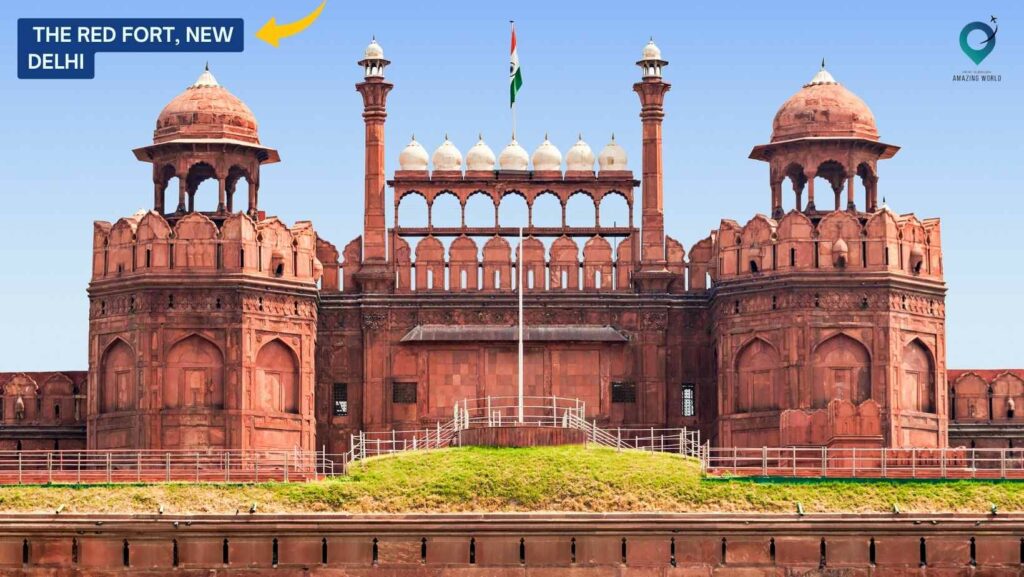
About the Place: The Red Fort, an iconic symbol of India’s rich history, stands majestically in the heart of Delhi. Built by Mughal Emperor Shah Jahan in the 17th century, this red sandstone fort was the main residence of the Mughal emperors for nearly 200 years.
The fort’s sprawling complex includes palaces, gardens, and museums, reflecting the grandeur of Mughal architecture. Today, it serves as a vibrant reminder of India’s heritage and a key venue for national events, such as the annual Independence Day celebrations.
Place Address: Netaji Subhash Marg, Lal Qila, Chandni Chowk, New Delhi, Delhi 110006, India.
How to Get There
By Air: Fly into Indira Gandhi International Airport (DEL) in New Delhi. From the airport, take a taxi or the Delhi Metro (Airport Express Line) to reach the city center, then a taxi or rickshaw to the Red Fort.
By Train: Old Delhi Railway Station (DLI) is the nearest major station, about 2 km from the Red Fort. From the station, take a cycle-rickshaw or auto-rickshaw to reach the fort.
By Metro: Take the Delhi Metro Yellow Line to Chandni Chowk Station, then walk or take a cycle-rickshaw to the Red Fort, about 1 km away.
By Road: Use a taxi, auto-rickshaw, or Delhi’s efficient bus system to reach the Red Fort. The main entrance is via Netaji Subhash Marg.
Local Transport in Delhi: Utilize the extensive metro network, buses, auto-rickshaws, and taxis for getting around the city.
Why to Visit: Visiting the Red Fort offers a deep dive into India’s Mughal past. The fort’s magnificent architecture, with its blend of Persian, Timurid, and Indian styles, is a feast for the eyes. Wander through the fort to explore its impressive structures, such as the Diwan-i-Aam (Hall of Public Audience) and the Rang Mahal (Palace of Colors).
The fort’s lush gardens provide a tranquil escape from the city’s hustle and bustle. The Light and Sound Show in the evening narrates the fort’s history and adds a dramatic touch to the visit, making the past come alive in a captivating way.
Daily Average Budget
- Entry Fee: ₹35 (Indian citizens), ₹550 (foreign tourists).
- Local Transport: ₹100-300 for auto-rickshaws/taxis.
- Food: ₹200-600 per person.
- Souvenirs: ₹100-500.
Estimated Total: ₹435-1950 per day.
Activities and Attractions
- Explore the Fort Complex: Visit the various halls, museums, and gardens within the fort.
- Attend the Light and Sound Show: Enjoy the evening show that depicts the fort’s history.
- Visit the Museums: Learn about Mughal history and Indian independence movements.
- Take a Guided Tour: Hire a guide for a more informative experience.
- Enjoy Street Food: Try local delicacies at nearby Chandni Chowk.
Things to Avoid
- Visiting During Peak Hours: To avoid large crowds, visit early in the morning or late afternoon.
- Overpacking: Carry only essentials, as security checks are thorough.
- Ignoring Weather Conditions: Delhi can be very hot in summer; dress accordingly and stay hydrated.
- Skipping the Audio Guide: The audio guide provides valuable insights into the fort’s history and architecture.
- Littering: Maintain cleanliness and respect the historic site.
6. The Gateway of India, Mumbai
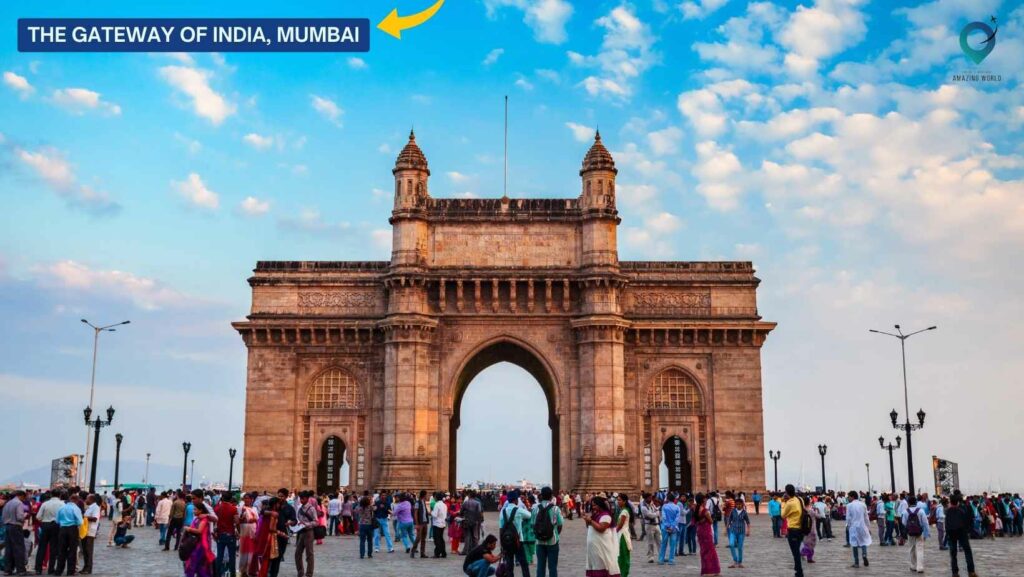
About the Place: The Gateway of India, Mumbai’s most recognized landmark, stands majestically overlooking the Arabian Sea. Built to commemorate the visit of King George V and Queen Mary to India in 1911, this archway of basalt and reinforced concrete blends Hindu and Muslim architectural styles.
Today, it serves as a bustling gathering spot and a starting point for exploring Mumbai. The surrounding area is a vibrant mix of street vendors, photographers, and ferry services, offering stunning views of the sea and the nearby Taj Mahal Palace Hotel.
Place Address: Apollo Bandar, Colaba, Mumbai, Maharashtra 400001, India.
How to Get There
By Air: Fly into Chhatrapati Shivaji Maharaj International Airport (BOM) in Mumbai. From the airport, take a taxi or the Mumbai Suburban Railway to reach the Gateway of India.
By Train: Chhatrapati Shivaji Maharaj Terminus (CST) is the nearest major station, about 2.5 km away. From there, take a taxi, bus, or local train to Churchgate Station, then a short taxi ride to the Gateway.
By Road: Use a taxi or Mumbai’s local buses to reach the Gateway of India. The location is well-connected and can also be reached by auto-rickshaw from nearby areas.
Local Transport in Mumbai: Utilize local trains, buses, taxis, and auto-rickshaws to get around the city. The Gateway is also a key point for ferries to Elephanta Island.
Why to Visit: The Gateway of India is not just a historical monument but also a vibrant hub that captures the essence of Mumbai. The structure itself, with its majestic arches and scenic location, is a must-see. The bustling promenade offers a lively atmosphere where you can enjoy the sea breeze, interact with locals, and indulge in street snacks. It’s also a launch point for ferry rides to the Elephanta Caves, adding to the adventure. The Gateway’s blend of history, architecture, and modern-day vibrancy makes it a symbol of Mumbai’s dynamic spirit.
Daily Average Budget
- Entry Fee: Free.
- Local Transport: ₹100-300 for taxis/buses.
- Food: ₹200-600 per person.
- Ferry Ride to Elephanta Caves: ₹200-300 per person.
Estimated Total: ₹500-1200 per day.
Activities and Attractions
- Admire the Gateway: Take in the architectural beauty and snap some photos.
- Take a Ferry to Elephanta Caves: Explore the ancient rock-cut temples on Elephanta Island.
- Stroll along the Promenade: Enjoy a leisurely walk along the waterfront.
- Visit the Taj Mahal Palace Hotel: Admire the architecture of this historic hotel nearby.
- Enjoy Street Food: Try local favorites like bhel puri and vada pav from street vendors.
Things to Avoid
- Unwanted Photography Offers: Politely decline unsolicited offers for photos from street photographers.
- Crowded Times: Visit early in the morning or late evening to avoid large crowds.
- Ignoring Weather: Mumbai’s coastal weather can be humid; dress comfortably and stay hydrated.
- Skipping the Ferry Ride: The ferry to Elephanta Caves is a key highlight; don’t miss it.
- Littering: Keep the area clean and respect the public space.
7. Mecca Masjid, Hyderabad
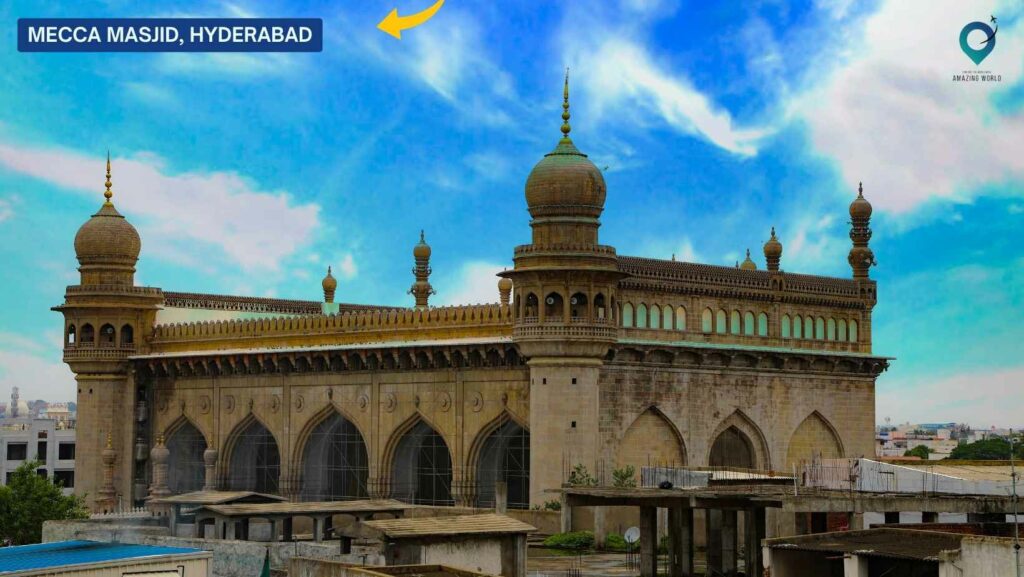
About the Place: Mecca Masjid, one of the largest and oldest mosques in India, is an architectural marvel nestled in the heart of Hyderabad. Built from bricks made with soil brought from Mecca, this grand mosque stands as a testament to Mughal splendor.
With its colossal arches, intricately designed minarets, and peaceful courtyard, Mecca Masjid exudes a serene aura, offering a spiritual retreat amidst the city’s bustling streets. It’s a place where history, faith, and stunning architecture come together, creating a profound and tranquil experience for visitors.
Place Address: Hyderabad, Telangana, 500002, India.
How to Get There
By Air: Arrive at Rajiv Gandhi International Airport (HYD). From there, take a taxi or an airport shuttle to the city center, then proceed to Mecca Masjid by taxi or auto-rickshaw.
By Train: Hyderabad Deccan Railway Station (HYB) is the nearest major station, about 4 km away. From the station, you can take a taxi or an auto-rickshaw to reach the mosque.
By Metro: Take the Hyderabad Metro Blue Line to the Charminar Station. From there, Mecca Masjid is a short walk or auto-rickshaw ride away.
By Road: Use local buses, taxis, or auto-rickshaws to reach the mosque. The location is near Charminar, one of Hyderabad’s major landmarks, making it easily accessible.
Why to Visit: Mecca Masjid is a place where architectural beauty and spiritual tranquility merge seamlessly. Its vast courtyard, capable of holding thousands of worshippers, offers a serene escape from the city’s bustle. The mosque’s history, dating back to the Mughal era, is reflected in its grand arches and ornate details. It’s a spiritual haven where you can experience the peaceful ambiance, marvel at the intricate stone carvings, and feel the profound sense of reverence that permeates the air. A visit to Mecca Masjid is a journey into the heart of Hyderabad’s cultural and religious heritage.
Daily Average Budget
- Entry Fee: Free.
- Local Transport: ₹50-200 for taxis/auto-rickshaws.
- Food: ₹150-500 per person (nearby restaurants or street food).
- Souvenirs: ₹100-300.
Estimated Total: ₹300-1000 per day.
Activities and Attractions
- Explore the Mosque: Admire the grand architecture and peaceful surroundings.
- Visit Charminar: Explore the iconic Charminar, just a short walk away.
- Indulge in Local Cuisine: Try local delicacies at nearby eateries.
- Shop at Laad Bazaar: Buy traditional bangles and textiles at the bustling market close to the mosque.
- Take a Guided Tour: Learn about the mosque’s history and significance from a local guide.
Things to Avoid
- Disrupting Prayer Services: Maintain silence and respect ongoing prayers.
- Wearing Inappropriate Clothing: Dress modestly, covering shoulders and knees.
- Visiting During Peak Hours: To avoid crowds, visit early in the morning or late afternoon.
- Littering: Keep the mosque and surrounding area clean.
- Photography Without Permission: Seek permission before taking photographs inside the mosque.
8. Amer Fort, Jaipur
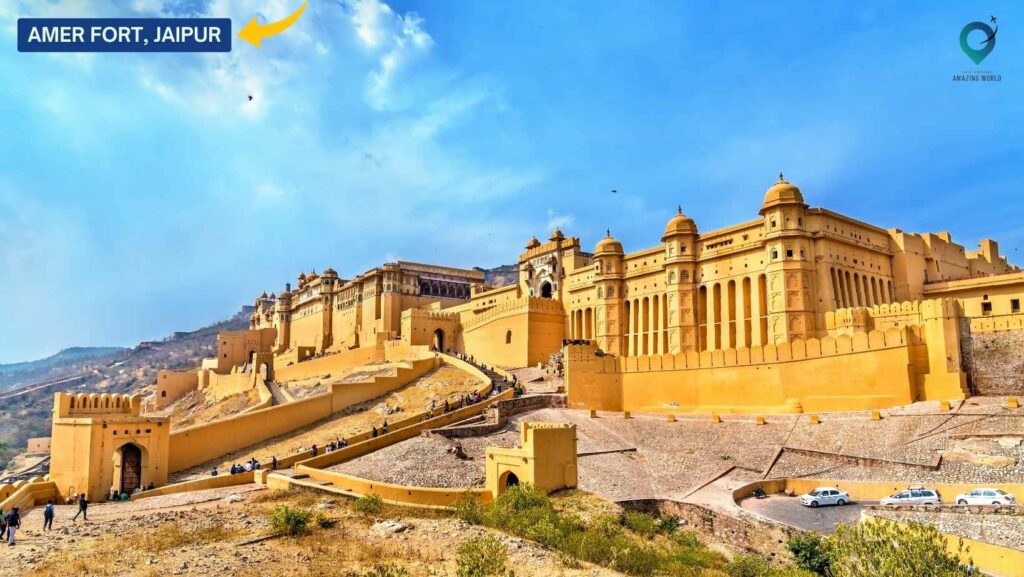
About the Place: Amer Fort, perched on a hill overlooking Maota Lake, is a magnificent example of Rajput architecture in Jaipur. This majestic fort, built from red sandstone and marble, showcases a blend of Hindu and Mughal styles. Its grand courtyards, intricate mirror work, and stunning frescoes reflect the opulence of the Rajput rulers. Amer Fort is not just a fort but a grand palace complex that takes visitors on a journey through the royal history and splendor of Rajasthan.
Place Address: Devisinghpura, Amer, Jaipur, Rajasthan 302001, India.
How to Get There
By Air: Fly into Jaipur International Airport (JAI). From the airport, take a taxi to Amer Fort, approximately 25 km away.
By Train: Jaipur Railway Station (JP) is about 13 km from Amer Fort. From the station, take a taxi, auto-rickshaw, or a bus to the fort.
By Road: Amer Fort is accessible via local buses, taxis, or auto-rickshaws. The main entrance is on Amer Road.
Why to Visit: Amer Fort is a stunning blend of history and architecture, offering a glimpse into the grandeur of Rajputana. As you walk through the massive gates and ornate courtyards, you’ll be transported to a time of royal opulence.
The Sheesh Mahal (Mirror Palace), with its intricate mirror work, creates a dazzling display of light. The fort’s strategic location and panoramic views of the surrounding landscape add to its allure. Amer Fort is a must-visit for its rich history, architectural splendor, and breathtaking scenery.
Daily Average Budget
- Entry Fee: ₹200 for Indian citizens, ₹550 for foreign tourists.
- Local Transport: ₹150-400 for taxis/auto-rickshaws.
- Food: ₹200-600 per person (nearby restaurants or cafes).
- Elephant Ride: ₹1000-1500 per person (optional).
Estimated Total: ₹550-2550 per day.
Activities and Attractions
- Explore the Palace: Visit the various halls, courtyards, and the Sheesh Mahal.
- Enjoy the Light and Sound Show: Attend the evening show that narrates the fort’s history.
- Take an Elephant Ride: Experience an elephant ride to the fort’s entrance.
- Visit the Suraj Pol and Ganesh Pol: Admire the intricate architecture of the fort’s gates.
- Walk the Fort Walls: Enjoy panoramic views from the fort’s ramparts.
Things to Avoid
- Visiting During Midday Heat: The fort can get very hot; visit in the early morning or late afternoon.
- Ignoring the Steep Path: Wear comfortable shoes as the path to the fort is steep.
- Missing the Light and Sound Show: It’s a key highlight that brings the fort’s history to life.
- Overpriced Souvenirs: Be cautious of high-priced souvenirs sold near the fort.
- Littering: Maintain cleanliness and respect the historic site.
9. Goa: The Ultimate Holiday Haven

About the Place: Goa, with its golden beaches, vibrant nightlife, and laid-back vibe, is India’s ultimate holiday destination. From sunbathing on pristine beaches to exploring Portuguese heritage in Old Goa, this coastal paradise offers a mix of relaxation and adventure. Whether you’re into water sports, savoring fresh seafood, or partying at beach clubs, Goa caters to every traveler’s whim. The state’s eclectic charm, with its blend of cultures, cuisine, and festivals, makes it a must-visit for those seeking a quintessential beach holiday.
Place Address: Goa, India (multiple locations across North and South Goa).
How to Get There
By Air: Fly into Goa International Airport (GOI), also known as Dabolim Airport. From the airport, take a taxi or a prepaid airport shuttle to your accommodation.
By Train: Madgaon Railway Station (MAO) in South Goa and Thivim Railway Station (THVM) in North Goa are major stations. From there, take a taxi or local bus to your destination.
By Road: Goa is accessible via NH 66 and NH 748. You can also take a bus from nearby cities like Mumbai or Bangalore. Buses and taxis are available to reach various parts of Goa.
Local Transport in Goa: Use rental bikes, scooters, taxis, or buses to explore the beaches and towns.
Why to Visit: Goa is synonymous with beach bliss and endless fun. Its long coastline is dotted with picturesque beaches, each with its vibe. Whether you’re lounging on Baga Beach, exploring the hippie markets of Anjuna, or enjoying a quiet sunset at Palolem, there’s a beach for every mood.
Beyond the beaches, Goa’s rich history is reflected in its Portuguese-era churches and forts. The lively nightlife, with beach parties and vibrant clubs, ensures the fun continues long after sunset. Goa’s diverse attractions and relaxed pace make it a perfect holiday destination.
Daily Average Budget
- Accommodation: ₹1500-5000 (depending on location and type).
- Food: ₹500-1500 per person.
- Local Transport: ₹300-800 for rental bikes/scooters.
- Activities: ₹500-2000 (water sports, club entry fees).
Estimated Total: ₹2800-9300 per day.
Activities and Attractions
- Beach Hopping: Visit popular beaches like Baga, Anjuna, and Palolem.
- Water Sports: Enjoy activities like parasailing, jet skiing, and snorkeling.
- Explore Old Goa: Visit the Basilica of Bom Jesus and Se Cathedral.
- Nightlife: Experience beach parties and clubs in North Goa.
- Shop at Flea Markets: Browse for souvenirs at Anjuna and Mapusa markets.
Things to Avoid
- Overcrowded Beaches: Visit less popular beaches to avoid crowds.
- Unregulated Water Sports: Ensure activities are conducted by certified operators.
- Neglecting Sun Protection: Wear sunscreen and stay hydrated.
- Nighttime Swimming: It’s unsafe due to strong currents.
- Overspending at Beach Shacks: Check prices before ordering to avoid surprises.
10. Periyar National Park and Wildlife Sanctuary, Madurai

About the Place: Periyar National Park and Wildlife Sanctuary, located in the Western Ghats of Kerala, is a haven for wildlife enthusiasts and nature lovers alike. Spread across lush greenery and centered around the picturesque Periyar Lake, this sanctuary is renowned for its rich biodiversity.
Home to elephants, tigers, sambar deer, and countless bird species, Periyar offers visitors a chance to explore its dense forests through guided treks, boat rides, and nature walks. The sanctuary’s tranquil ambiance and stunning landscapes make it a must-visit for those seeking a close encounter with nature in its pristine form.
Place Address: Thekkady, Kumily, Idukki District, Kerala 685536, India.
How to Get There
By Air: The nearest airport is Madurai Airport (IXM), approximately 140 km away. From there, you can take a taxi or a bus to reach Periyar National Park.
By Train: Kottayam Railway Station (KTYM) is the nearest major railhead, about 114 km away. From Kottayam, you can hire a taxi or take a bus to Thekkady.
By Road: Periyar is well-connected by road. You can drive from nearby cities like Madurai (140 km), Kochi (160 km), or Thiruvananthapuram (260 km). Buses and private taxis are available.
Why to Visit: Periyar National Park offers a unique opportunity to witness wildlife in their natural habitat amidst stunning surroundings. Whether you’re cruising on Periyar Lake, trekking through the forest trails, or birdwatching from designated viewpoints, every moment here is filled with the sights and sounds of the wilderness.
The sanctuary’s commitment to conservation and eco-tourism ensures a sustainable experience, where visitors can learn about local flora and fauna while contributing to its preservation. For nature enthusiasts and adventure seekers, Periyar promises an unforgettable journey into the heart of Kerala’s natural beauty.
Daily Average Budget
- Entry Fee: ₹50 for Indian citizens, ₹500 for foreign tourists (boat ride fees extra).
- Accommodation: ₹1000-3000 per night (budget to mid-range options).
- Food: ₹300-800 per person (local restaurants or hotels).
- Activities: ₹300-1000 (boat rides, guided treks).
Estimated Total: ₹1650-4300 per day.
Activities and Attractions
- Boat Safari: Cruise on Periyar Lake to spot wildlife like elephants and birds.
- Nature Walks: Explore the sanctuary’s trails with knowledgeable guides.
- Bamboo Rafting: Experience a serene rafting trip on the lake’s placid waters.
- Visit Spice Plantations: Discover the region’s spice gardens and learn about spice cultivation.
- Kalaripayattu Show: Watch a traditional martial arts performance in Thekkady.
Things to Avoid
- Feeding Wildlife: Respect guidelines and refrain from feeding animals.
- Unauthorized Trekking: Only participate in guided treks sanctioned by the sanctuary.
- Littering: Maintain cleanliness and dispose of waste responsibly.
- Disrupting the Peace: Maintain silence during wildlife sightings.
- Ignoring Safety Guidelines: Follow instructions during boat rides and treks for your safety.
11. Agra Fort

About the Place: Agra Fort, a UNESCO World Heritage Site, stands as a testament to the grandeur of the Mughal Empire in India. Built primarily from red sandstone, this colossal fortress served as the main residence of the emperors of the Mughal dynasty until 1638. Its impressive architecture, including intricate carvings, sprawling courtyards, and marble palaces, reflects a blend of Islamic, Persian, and Hindu influences. Agra Fort not only showcases the military prowess of its builders but also provides a glimpse into the rich history and cultural heritage of India.
Place Address: Agra Fort, Rakabganj, Agra, Uttar Pradesh 282003, India.
How to Get There
By Air: Fly into Agra Airport (AGR). From there, Agra Fort is about 10 km away. Taxis and auto-rickshaws are readily available.
By Train: Agra Fort Railway Station (AF) is adjacent to the fort. It’s well-connected to major cities like Delhi and Jaipur via express trains.
By Road: Agra is well-connected by roadways. National Highway 19 and other state highways link it to major cities like Delhi (about 230 km) and Jaipur (about 240 km).
Local Transport in Agra: Use auto-rickshaws, cycle rickshaws, or taxis to reach Agra Fort and explore other nearby attractions.
Why to Visit: Agra Fort is more than just a fortress; it’s a symbol of architectural brilliance and historical significance. As you walk through its massive gates and royal chambers, you can imagine the grandeur of the Mughal era.
The Diwan-i-Khas (Hall of Private Audience), with its exquisite marble pavilions, and the Sheesh Mahal (Mirror Palace) are highlights that showcase the empire’s opulence. Beyond its architectural marvels, Agra Fort offers panoramic views of the Taj Mahal across the Yamuna River, making it a must-visit for history buffs and admirers of India’s rich cultural heritage.
Daily Average Budget
- Entry Fee: ₹50 for Indian citizens, ₹650 for foreign tourists.
- Accommodation: ₹1000-3000 per night (budget to mid-range options).
- Food: ₹300-800 per person (local restaurants or hotels).
- Transport: ₹100-500 (depending on distance and mode of transport).
Estimated Total: ₹1450-3950 per day.
Activities and Attractions
- Explore the Palace Complex: Visit the Diwan-i-Aam, Diwan-i-Khas, and other royal chambers.
- Sheesh Mahal: Admire the intricate mirror work in this beautiful palace.
- Jahangir Palace: Discover the residential quarters of Emperor Jahangir.
- Musamman Burj: Enjoy views of the Taj Mahal from this octagonal tower.
- Light and Sound Show: Attend the evening show that brings the fort’s history to life.
Things to Avoid
- Unauthorized Guides: Hire authorized guides for accurate historical information.
- Touching Artifacts: Respect the preservation of historical artifacts and structures.
- Photography Restrictions: Follow rules regarding photography inside the fort.
- Ignoring Safety Precautions: Be cautious on uneven paths and steep staircases.
- Crowded Hours: Visit early morning or late afternoon to avoid crowds.
12. The Ellora Caves, Aurangabad

About the Place: The Ellora Caves, a UNESCO World Heritage Site, is an architectural marvel carved into the Charanandri Hills near Aurangabad. These ancient rock-cut caves represent a fusion of Buddhist, Hindu, and Jain religious art dating from the 6th to 10th centuries CE.
The complex consists of 34 caves, each adorned with intricate sculptures and frescoes depicting deities, mythological scenes, and daily life. The Kailasa Temple, a highlight of Ellora, is the world’s largest monolithic structure carved from a single rock. Ellora Caves stands as a testament to India’s rich cultural and religious diversity.
Place Address: Ellora Caves, Ellora, Maharashtra 431102, India.
How to Get There
By Air: Fly into Aurangabad Airport (IXU). From there, Ellora Caves are about 30 km away. Taxis and buses are available at the airport.
By Train: Aurangabad Railway Station (AWB) is the nearest major station, approximately 30 km from Ellora. Taxis, auto-rickshaws, and buses connect the station to the caves.
By Road: Ellora is well-connected by road. It’s about 12 km northwest of Aurangabad city. Local buses, taxis, and auto-rickshaws are available for transportation.
Why to Visit: Ellora Caves is a treasure trove of ancient Indian art and architecture, offering a glimpse into the country’s rich cultural tapestry. From the majestic Kailasa Temple, with its intricate carvings and towering pillars, to the serene Buddhist viharas and elaborate Hindu shrines, each cave tells a story of devotion and craftsmanship.
The site’s historical significance, combined with its awe-inspiring beauty, attracts history enthusiasts, archaeologists, and spiritual seekers alike. Ellora Caves is a journey back in time, where you can marvel at the ingenuity of ancient artisans and immerse yourself in India’s religious heritage.
Daily Average Budget
- Entry Fee: ₹30 for Indian citizens, ₹500 for foreign tourists.
- Accommodation: ₹800-2500 per night (budget to mid-range options in Aurangabad).
- Food: ₹200-700 per person (local restaurants or hotels).
- Transport: ₹100-400 (depending on distance and mode of transport).
Estimated Total: ₹1130-4100 per day.
Activities and Attractions
- Visit Kailasa Temple: Explore the monumental rock-cut temple dedicated to Lord Shiva.
- Buddhist Caves: Discover the serene viharas and chaityas adorned with Buddhist art.
- Hindu Caves: Marvel at the intricate sculptures and elaborate carvings in the Hindu caves.
- Sculpture Gallery: Admire the ancient sculptures and frescoes depicting mythological tales.
- Light and Sound Show: Experience the historical narratives through an evening show.
Things to Avoid
- Touching Artifacts: Preserve the integrity of the ancient sculptures and carvings.
- Unauthorized Guides: Hire authorized guides for insightful information.
- Littering: Maintain cleanliness and respect the sanctity of the site.
- Ignoring Safety Signs: Follow rules and warnings at the caves.
- Photography Restrictions: Adhere to guidelines regarding photography inside the caves.
13. Mehrangarh Fort, Jodhpur
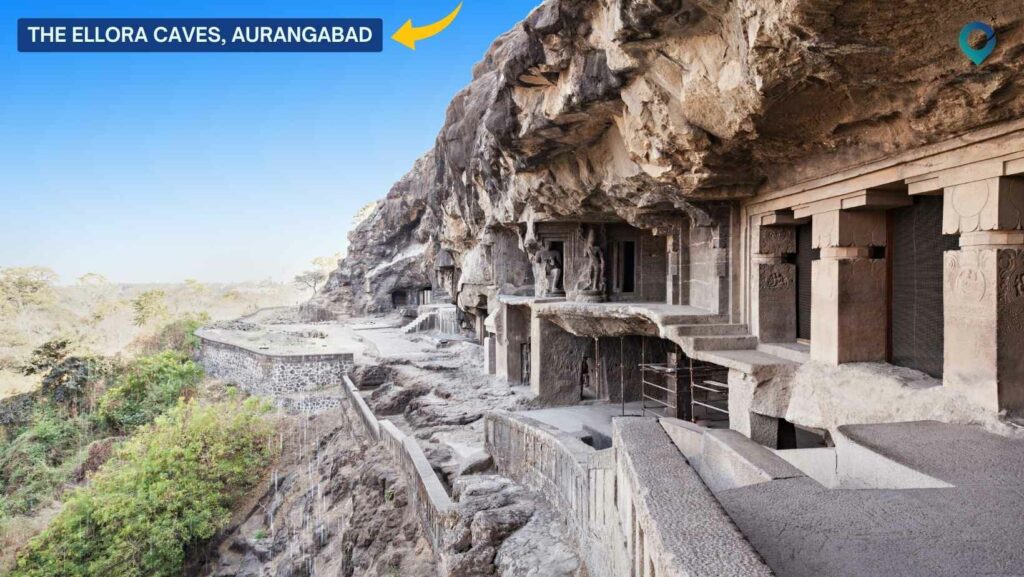
About the Place: Mehrangarh Fort, perched majestically on a rocky hilltop in Jodhpur, Rajasthan, is one of India’s largest and most impressive forts. Built in the 15th century by Rao Jodha, the founder of Jodhpur, this formidable structure offers breathtaking views of the Blue City below.
The fort’s massive walls enclose palaces adorned with intricate latticed windows, courtyards, and museums displaying royal artifacts and weaponry. Mehrangarh Fort’s architecture, blending Rajputana and Mughal styles, evokes a sense of grandeur and resilience, making it a must-visit for history buffs and architectural enthusiasts.
Place Address: Mehrangarh Fort, Fort Rd, Jodhpur, Rajasthan 342006, India.
How to Get There
By Air: Fly into Jodhpur Airport (JDH). From the airport, Mehrangarh Fort is about 5 km away. Taxis and auto-rickshaws are readily available.
By Train: Jodhpur Railway Station (JU) is well-connected to major cities like Delhi and Jaipur. The fort is about 3 km from the station, accessible by taxis and auto-rickshaws.
By Road: Jodhpur is well-connected by roadways. National Highway 62 and other state highways connect it to major cities like Jaipur (about 340 km) and Udaipur (about 250 km). Local buses, taxis, and auto-rickshaws are available for transportation within the city.
Why to Visit: Mehrangarh Fort is more than just a historical monument; it’s a living testament to Rajasthan’s royal legacy. As you wander through its intricately decorated palaces like Moti Mahal (Pearl Palace) and Phool Mahal (Flower Palace), you’ll marvel at the craftsmanship of bygone eras.
The fort’s expansive courtyards and panoramic viewpoints offer stunning vistas of Jodhpur’s skyline, especially during sunrise and sunset. Visitors can delve into Jodhpur’s rich cultural heritage through music performances, cultural festivals, and exhibitions held within the fort premises. Mehrangarh Fort promises an enriching experience for those captivated by history, architecture, and the regal charm of Rajasthan.
Daily Average Budget
- Entry Fee: ₹100 for Indian citizens, ₹600 for foreign tourists (includes audio guide).
- Accommodation: ₹1000-3000 per night (budget to mid-range options in Jodhpur).
- Food: ₹300-800 per person (local restaurants or hotels).
- Transport: ₹100-500 (depending on distance and mode of transport).
Estimated Total: ₹1500-3900 per day.
Activities and Attractions
- Palace Museums: Explore the rich collections of art, weaponry, and textiles in the fort’s museums.
- Panoramic Views: Capture stunning views of Jodhpur’s Blue City from various vantage points.
- Cultural Performances: Attend traditional music and dance performances held within the fort.
- Historical Walks: Take guided tours to learn about the fort’s history and architectural significance.
- Shopping: Browse for local handicrafts, textiles, and souvenirs at the fort’s shops.
Things to Avoid
- Unauthorized Guides: Opt for authorized guides for accurate historical insights.
- Touching Artifacts: Respect preservation efforts and avoid touching historical artifacts.
- Photography Restrictions: Follow guidelines regarding photography inside certain areas of the fort.
- Littering: Help maintain cleanliness within the fort premises.
- Ignoring Safety Signs: Be mindful of safety precautions, especially on steep pathways.
14. The Ganges River
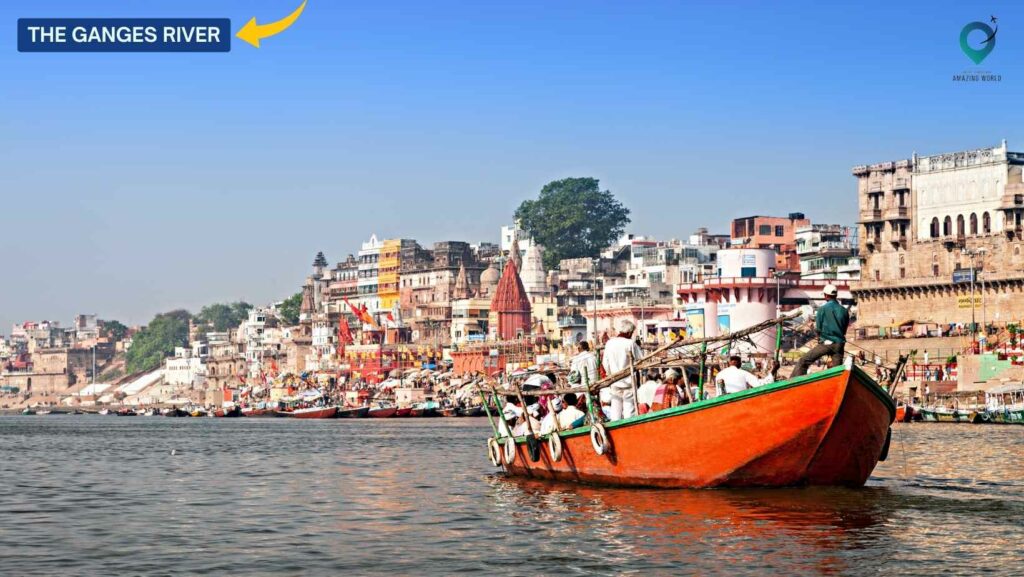
About the Place: The Ganges River, often revered as the holiest river in India, flows through the plains of North India, from the Himalayas to the Bay of Bengal. Stretching over 2500 kilometers, the Ganges holds immense spiritual and cultural significance for Hindus. Varanasi, Allahabad, and Haridwar are among the sacred cities located along its banks, where pilgrims flock to perform rituals and immerse themselves in its purifying waters.
The Ganges River sustains millions of people along its course and serves as a lifeline for agriculture, transport, and cultural practices. Beyond its religious importance, the river’s scenic beauty and cultural diversity make it a symbol of India’s spiritual heritage.
Place Address: The Ganges River flows through multiple states in North India, including Uttarakhand, Uttar Pradesh, Bihar, and West Bengal.
How to Get There
By Air: Fly into airports near cities along the Ganges, such as Varanasi (VNS), Allahabad (IXD), or Kolkata (CCU). From there, local transport options are available to reach the riverbanks.
By Train: Major railway stations in cities like Varanasi, Allahabad, and Kolkata provide convenient access to the Ganges. Local transport, including auto-rickshaws and taxis, can be used to reach river ghats.
By Road: National highways and state roads connect cities along the Ganges. Local buses, taxis, and auto-rickshaws are available for transportation within these cities and to river ghats.
Local Transport: Use boats, ferries, or hired boats to navigate the Ganges River at various points, especially in cities like Varanasi and Kolkata.
Why to Visit: The Ganges River offers a profound cultural and spiritual experience, whether you witness the morning rituals at Varanasi’s ghats or attend the grand Kumbh Mela in Allahabad. For Hindus, bathing in the Ganges is believed to cleanse sins and attain salvation. Boat rides along its meandering course reveal bustling river life, ancient temples, and vibrant markets lining its banks.
The Ganges isn’t just a river; it’s a symbol of devotion, resilience, and the cyclical nature of life in India. Visitors can explore its cultural richness through religious ceremonies, riverside walks, and interactions with local communities, gaining a deeper appreciation for India’s spiritual traditions.
Daily Average Budget
- Varies: Depending on the city and activities planned.
- Accommodation: ₹1000-3000 per night (budget to mid-range options in cities like Varanasi or Allahabad).
- Food: ₹300-800 per person (local restaurants or street food).
- Transport: ₹100-500 (depending on distance and mode of transport).
Estimated Total: ₹1500-3900 per day (varies based on location and activities).
Activities and Attractions
- Ghat Rituals: Witness morning and evening rituals, including Aarti ceremonies, at river ghats.
- Boat Rides: Take a boat tour to explore the river and visit temples along its banks.
- Ganges Aarti: Attend the mesmerizing Ganga Aarti ceremonies held at prominent ghats.
- Explore Riverside Temples: Visit ancient temples dedicated to various Hindu deities.
- Cultural Walks: Stroll along the ghats to observe daily life and interact with pilgrims.
Things to Avoid
- Disrespecting Rituals: Maintain decorum during religious ceremonies and rituals.
- Polluting the River: Avoid littering and contribute to efforts to keep the river clean.
- Unauthorized Boat Rides: Opt for registered boat services and negotiate fares beforehand.
- Ignoring Safety Precautions: Be cautious near riverbanks and follow safety guidelines during boat rides.
- Overly Commercialized Areas: Seek authentic experiences away from overly touristy spots.
15. Mysore Palace
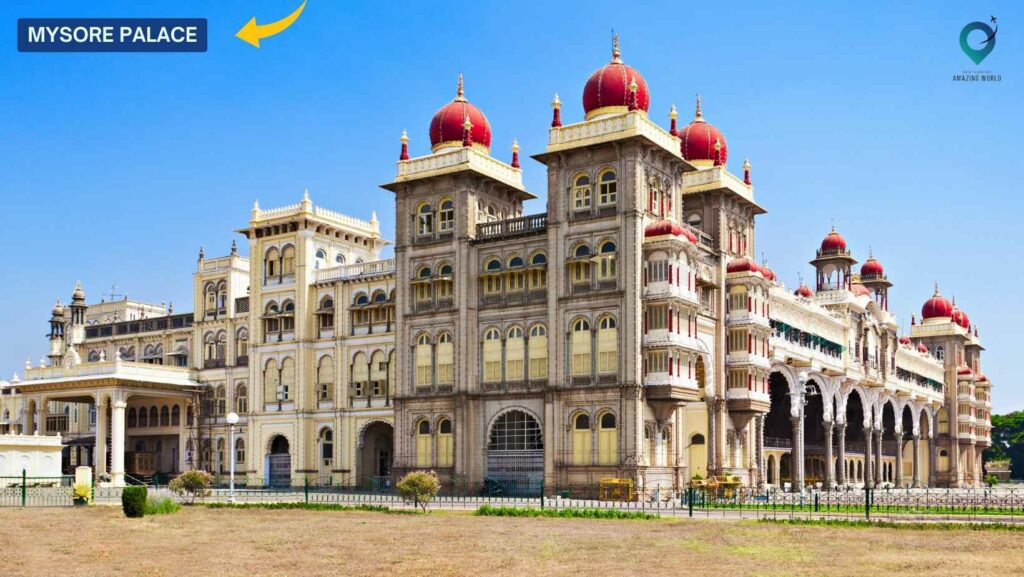
About the Place: Mysore Palace, also known as the Amba Vilas Palace, is a splendid example of Indo-Saracenic architecture and one of the most visited attractions in India. Located in the heart of Mysore, Karnataka, this majestic palace was originally built in the 14th century and later reconstructed in its current grandeur in the early 20th century. The palace showcases a harmonious blend of Hindu, Muslim, Rajput, and Gothic architectural styles, with intricately carved domes, arches, and pillars.
The interior is equally breathtaking, adorned with elaborate ceilings, stained glass windows, and vibrant frescoes depicting mythological scenes and royal portraits. Mysore Palace is not just a symbol of the city’s royal heritage but also hosts cultural events, including the famous Mysore Dasara festival, making it a cultural hub and a must-visit destination for history enthusiasts and architecture lovers alike.
Place Address: Mysore Palace, Sayyaji Rao Rd, Agrahara, Chamrajpura, Mysuru, Karnataka 570001, India.
How to Get There
By Air: The nearest airport is Mysore Airport (MYQ), located about 10 km from the city center. Taxis and auto-rickshaws are available for transportation to Mysore Palace.
By Train: Mysore Junction (MYS) is well-connected to major cities like Bangalore and Chennai. The palace is approximately 2 km from the railway station, accessible by auto-rickshaws and taxis.
By Road: Mysore is well-connected by roadways. National Highway 275 and state highways connect it to major cities like Bangalore (about 150 km) and Mangalore (about 250 km). Local buses, taxis, and auto-rickshaws are available for transportation within the city.
Why to Visit: Mysore Palace offers a glimpse into the opulent lifestyle of the Wadiyar dynasty, who ruled Mysore for centuries. The palace’s architectural splendor, highlighted by its durbar halls, private chambers, and intricately designed courtyards, transports visitors to a bygone era of royal extravagance. Beyond its historical significance, Mysore Palace hosts vibrant cultural performances, including classical music concerts and dance recitals, during the annual Dasara festivities.
Visitors can immerse themselves in the rich tapestry of Mysore’s cultural heritage, explore the palace’s museum showcasing royal artifacts, and witness the grandeur of the illuminated palace facade at night. Mysore Palace stands as a testament to Karnataka’s regal legacy and continues to enthrall tourists with its timeless allure.
Daily Average Budget
- Entry Fee: ₹70 for Indian citizens, ₹200 for foreign tourists (includes audio guide).
- Accommodation: ₹1000-3000 per night (budget to mid-range options in Mysore).
- Food: ₹300-800 per person (local restaurants or hotels).
- Transport: ₹100-500 (depending on distance and mode of transport).
Estimated Total: ₹1470-3500 per day.
Activities and Attractions
- Palace Museum: Explore the royal artifacts, costumes, and paintings displayed in the palace museum.
- Sound and Light Show: Attend the evening sound and light show that narrates the history of Mysore Palace.
- Dasara Festival: Experience the grandeur of Mysore Dasara celebrations, including the procession of decorated elephants and cultural performances.
- Photography: Capture the intricate architecture and scenic beauty of the palace and its surroundings.
- Shopping: Browse for local handicrafts and souvenirs near the palace complex.
Things to Avoid
- Unauthorized Photography: Respect guidelines regarding photography inside certain areas of the palace.
- Touching Artifacts: Maintain distance from delicate artifacts and exhibits to preserve them.
- Disrespecting Cultural Norms: Observe decorum during religious ceremonies or cultural events held at the palace.
- Littering: Help maintain cleanliness within the palace premises and surrounding areas.
- Overcrowded Areas: Plan visits during non-peak hours to avoid large crowds, especially during festivals.
16. Mahabodhi Temple, Bodhgaya
About the Place: The Mahabodhi Temple in Bodhgaya, Bihar, is one of the most revered pilgrimage sites for Buddhists worldwide. It marks the spot where Gautama Buddha attained enlightenment under the Bodhi Tree, making it a significant spiritual and historical landmark. Originally built in the 3rd century BCE by Emperor Ashoka, the temple complex underwent several renovations over the centuries.
The current structure, built in the 5th-6th century CE, showcases classical Indian architecture with a towering pyramidal spire and intricate carvings depicting scenes from Buddha’s life. The temple’s sanctum houses a large gilded image of Buddha in a deep state of meditation, creating a serene atmosphere conducive to meditation and reflection. Pilgrims and visitors from around the globe flock to the Mahabodhi Temple to pay homage, meditate under the Bodhi Tree, and experience the profound spiritual energy that permeates this sacred site.
Place Address: Mahabodhi Temple Complex, Gaya District, Bodhgaya, Bihar 824231, India.
How to Get There
By Air: The nearest airport is Gaya Airport (GAY), located about 10 km from Bodhgaya. Taxis and auto-rickshaws are available for transportation to the Mahabodhi Temple.
By Train: Gaya Junction (GAYA) is the closest major railway station, approximately 17 km from Bodhgaya. Auto-rickshaws and taxis can be hired from the station to reach the temple complex.
By Road: Bodhgaya is well-connected by roadways. National Highway 31 and state highways connect it to major cities like Patna (about 100 km) and Varanasi (about 250 km). Local buses, taxis, and auto-rickshaws are available for transportation within the town.
Why to Visit: The Mahabodhi Temple is not only a place of worship but also a symbol of enlightenment and peace. It attracts Buddhist devotees and spiritual seekers seeking solace and spiritual growth. The serene ambiance of the temple complex, surrounded by monasteries and meditation gardens, fosters a contemplative atmosphere ideal for meditation and introspection. Visitors can explore the ancient stupas, shrines, and Buddhist monasteries that dot Bodhgaya, retracing the footsteps of Buddha’s spiritual journey.
The Mahabodhi Temple’s historical significance, coupled with its architectural beauty and spiritual allure, makes it a must-visit destination for those interested in Buddhism and Eastern spirituality.
Daily Average Budget
- Entry Fee: ₹50 for Indian citizens, ₹200 for foreign tourists.
- Accommodation: ₹800-2500 per night (budget to mid-range options in Bodhgaya).
- Food: ₹200-600 per person (local eateries or guesthouses).
- Transport: ₹50-300 (depending on distance and mode of transport).
Estimated Total: ₹1100-3600 per day.
Activities and Attractions
- Bodhi Tree: Meditate under the sacred Bodhi Tree where Buddha attained enlightenment.
- Mahabodhi Temple Complex: Explore the temple’s architecture, including the main shrine and surrounding stupas.
- Buddhist Monasteries: Visit nearby monasteries representing different Buddhist traditions and cultures.
- Meditation Retreats: Participate in meditation sessions and retreats offered by local monasteries.
- Cultural Programs: Attend chanting sessions and religious ceremonies held at the Mahabodhi Temple.
Things to Avoid
- Disrespecting Sacred Sites: Maintain decorum and respect local customs and traditions.
- Disturbing Meditation Practices: Avoid unnecessary noise and disturbance near meditation areas.
- Unauthorized Photography: Follow guidelines regarding photography inside the temple and near the Bodhi Tree.
- Littering: Dispose of trash responsibly and help maintain cleanliness within the temple complex.
- Overcommercialisation: Seek authentic spiritual experiences and avoid overly touristy approaches.
A Beginner’s Guide to India: Travel Tips for First-Time Visitors

| Aspect | Details |
| Visa Requirements | – Obtain a tourist visa before arrival. |
| Currency | – Indian Rupee (INR). |
| Language | – Official: Hindi. – Commonly spoken: English, especially in tourist areas. |
| Best Time to Visit | – October to March (cooler and drier weather). |
| Weather | Varies by region: – North (cold winters, hot summers). – South (moderate year-round). – Himalayas (cold). |
| Health | – Vaccinations: Check recommended vaccinations (e.g., Hepatitis A, Typhoid, Tetanus). – Water: Drink bottled or boiled water. |
| Safety | – Be cautious with food hygiene. – Use reputable transport services. – Beware of scams and pickpocketing, especially in crowded areas. |
| Local Transport | – Taxis, auto-rickshaws, buses, and metro (in major cities). – Negotiate fares before boarding. |
| Accommodation | – Range from budget hostels to luxury hotels. – Book in advance, especially during peak tourist seasons. |
| Food | – Try local cuisine but be cautious with street food. – Eat at good restaurants. |
| Culture and Etiquette | – Respect local customs and traditions (e.g., dress modestly at religious sites). – Remove shoes before entering temples. |
| Must-Visit Places | – Examples: Taj Mahal (Agra), Jaipur (Pink City), Kerala (Backwaters). |
| Communication | – SIM card: Purchase at airports or local shops. – Internet: Available but speeds vary. |
| Electricity | – Standard voltage: 230V. – Type of plugs: Type C (European) and Type D (Indian). |
| Emergency Contacts | – Police: 100. – Ambulance: 102. – Tourist Helpline: 1363 (available in major cities). |
| Cultural Events and Festivals | – Experience Diwali (Festival of Lights), Holi (Festival of Colors), and local cultural events. |
| Shopping | – Bargain in markets (e.g., Delhi’s Chandni Chowk, Jaipur’s Johari Bazaar). – Check authenticity of items (e.g., handicrafts, textiles). |
| Money Matters | – ATMs are widely available; inform your bank of travel plans to avoid card issues. – Carry small denominations for convenience. |
| Travel Insurance | – Recommended for medical emergencies, trip cancellations, and theft. |
| Environmental Awareness | – Avoid single-use plastics. – Respect wildlife and natural habitats (e.g., national parks). |
Conclusion.
India offers a rich tapestry of culture, history, and natural beauty, making it a captivating destination for travelers. From the iconic Taj Mahal to vibrant festivals like Diwali, the country enchants with its diversity. However, navigating India requires preparation and awareness of cultural norms, health precautions, and local customs.
By embracing the adventure with an open mind and respecting the nuances of this dynamic land, visitors can truly savor the unforgettable experiences India has to offer. Whether exploring bustling cities or tranquil landscapes, India promises a journey filled with discovery and wonder.
How much did you like Our detailed India Most Famous Places: 16 Must-Visit Tourist Attractions in 2024? Review Also, please share these Blogs with your friends on social media.
Related Article –

Meet David Hoper, a passionate travel Blog writer with 7+ years of experience in travel content. Through his exemplary storytelling and engaging narratives, he shares his experiences and brings destinations to life. With a keen eye for detail and a love for exploration, he has cultivated a diverse portfolio of travel blogs that inspire and inform readers worldwide.
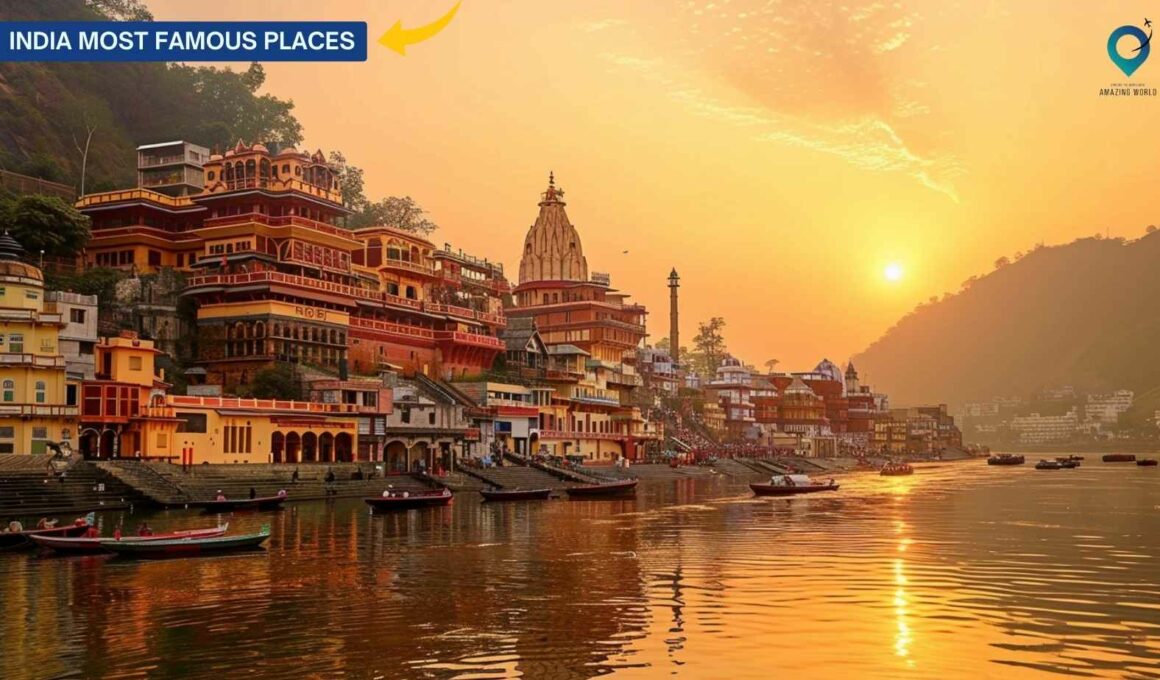

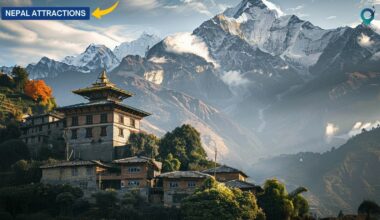

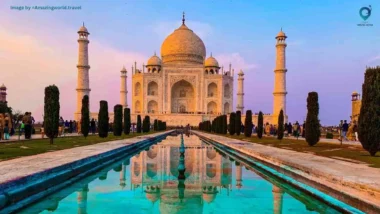
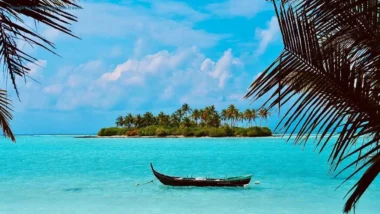
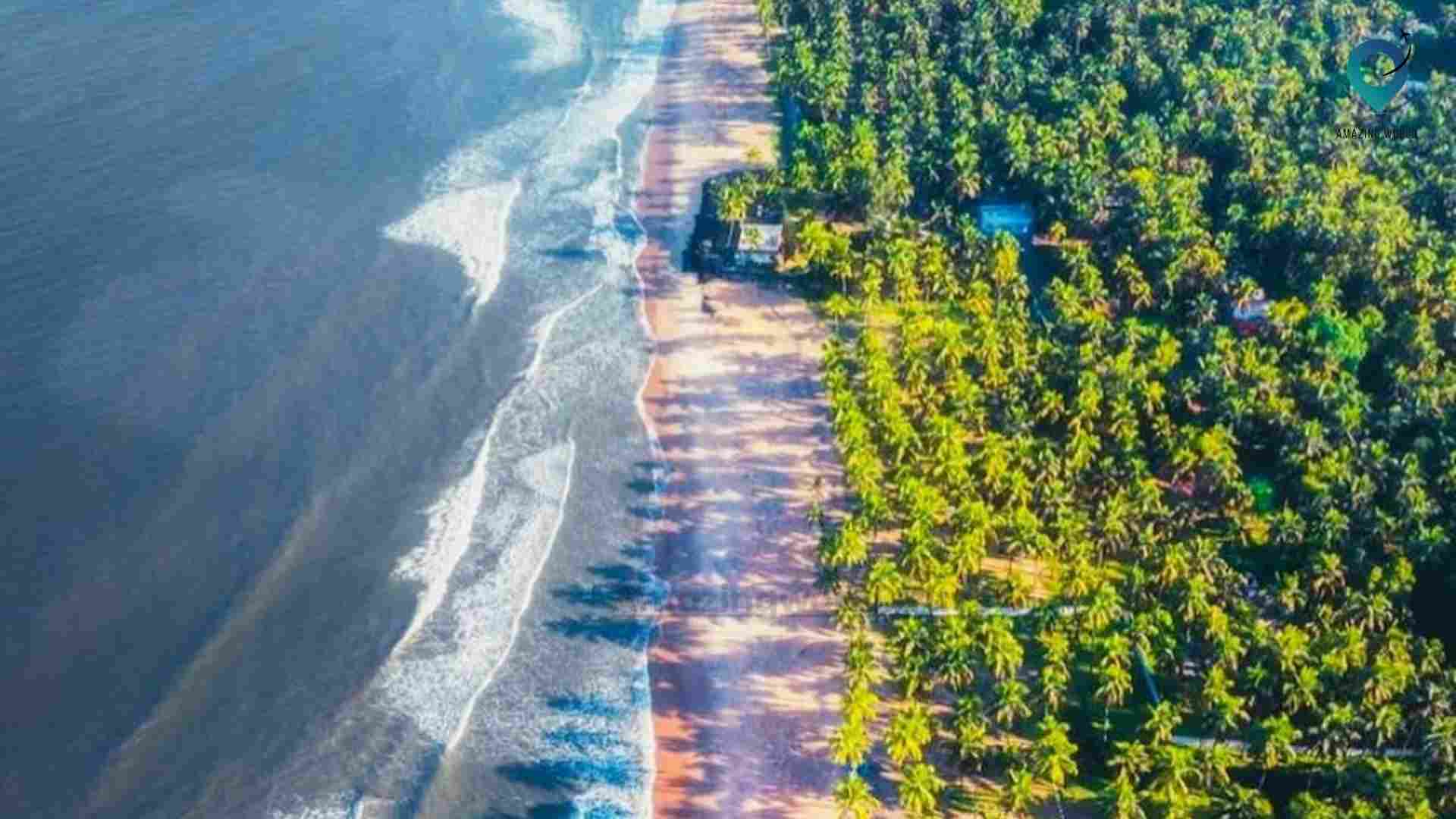
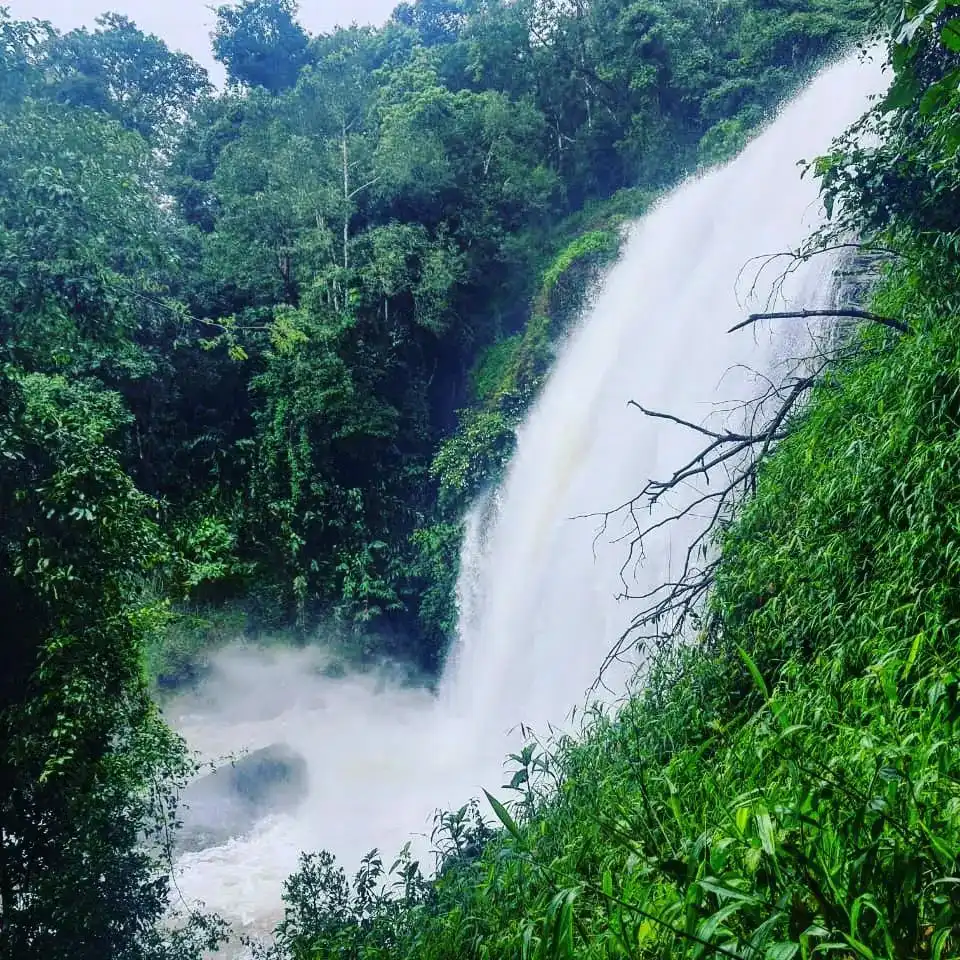

1 comment